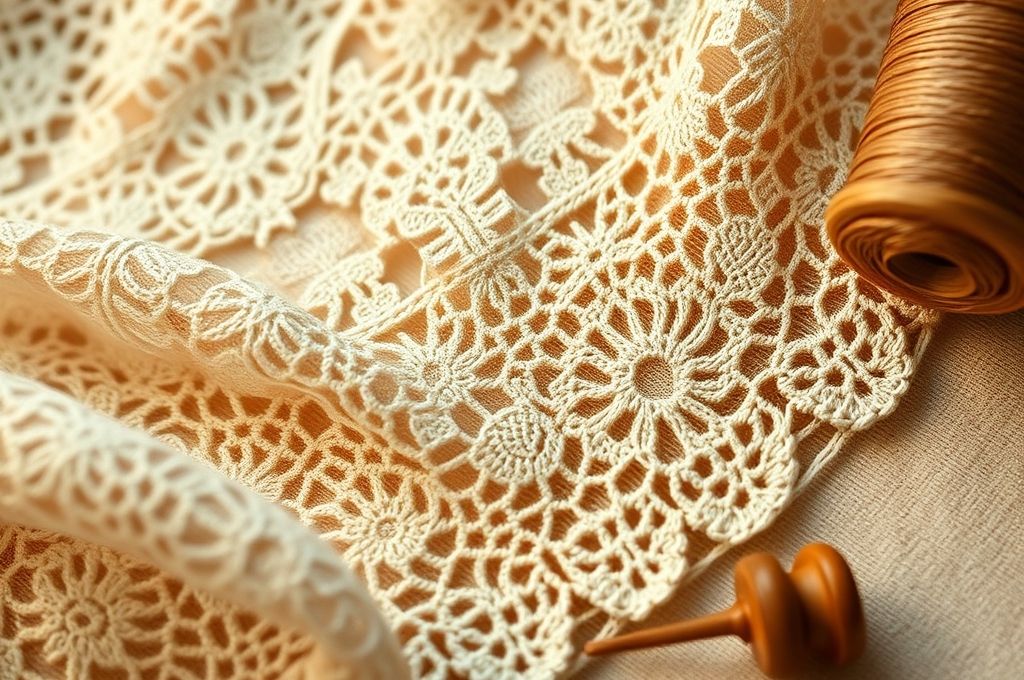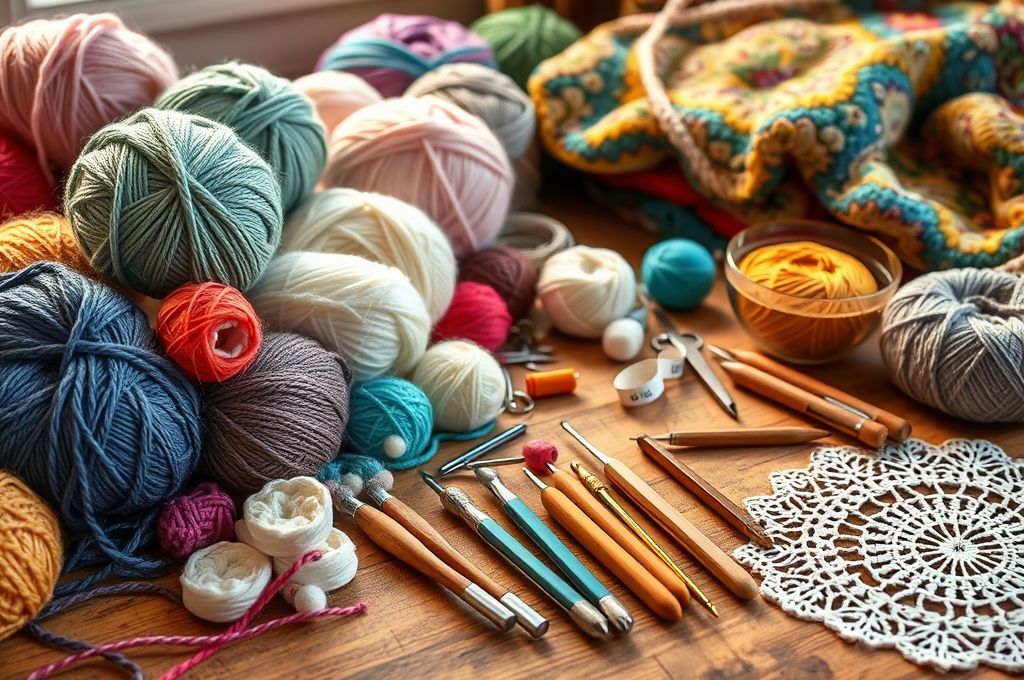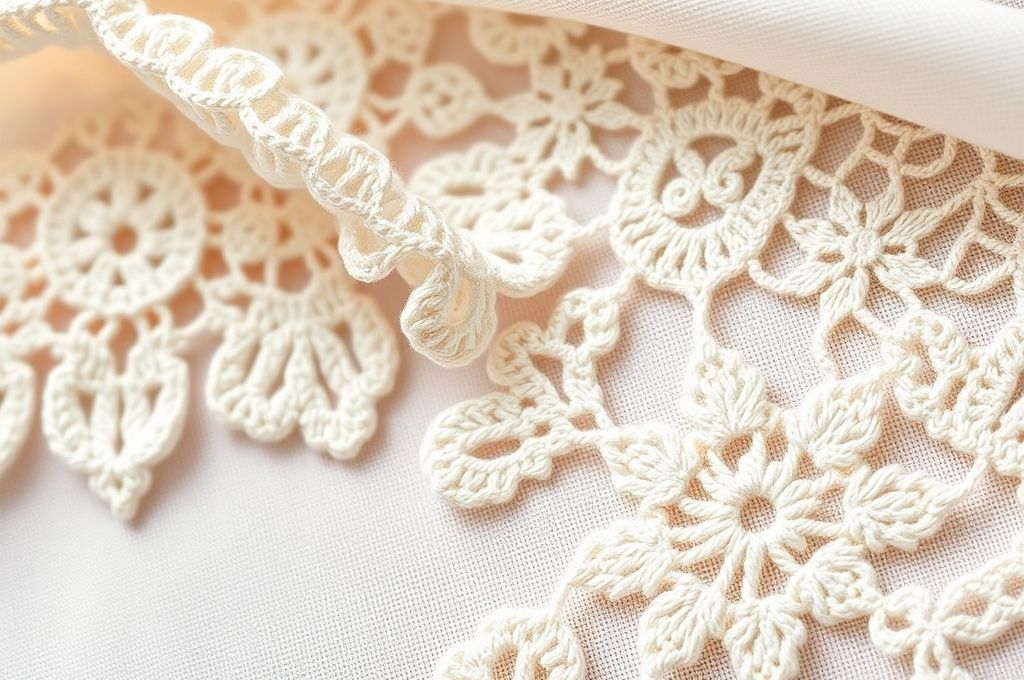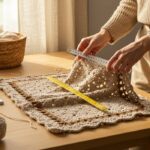The Timeless Beauty of Lace Crochet
Imagine holding a delicate doily passed down from your grandmother—its intricate loops and airy patterns whispering stories of patience, love, and craftsmanship. Or picture yourself wearing a lightweight summer shawl, its lace design catching the breeze like a soft sigh. This is the magic of lace crochet patterns: an art form that transforms simple yarn and a hook into breathtaking, ethereal fabrics.
Lace crochet isn’t just about making pretty things—it’s a celebration of creativity, mindfulness, and tradition. Whether you’re a seasoned crocheter or just picking up a hook for the first time, lace patterns offer a unique blend of challenge and reward. From vintage-inspired edgings to modern boho garments, lace crochet adds elegance and texture to any project.
In this article, we’ll explore the world of lace crochet patterns, uncovering their history, techniques, and endless creative possibilities. You’ll learn how to get started, choose the right materials, master essential stitches, and avoid common mistakes. We’ll also dive into inspiring project ideas and show you how lace crochet can be both a relaxing hobby and a meaningful form of self-expression.
So grab your favorite yarn, settle into a cozy chair, and let’s unravel the delicate threads of lace crochet together. Whether you’re dreaming of heirloom table runners or a breezy beach cover-up, this journey into the art of lace is sure to spark your imagination.
The History and Evolution of Lace Crochet

Lace has long been a symbol of refinement and artistry. Before machines could replicate its complexity, lace was painstakingly handmade using techniques like bobbin lace and needle lace. But in the 19th century, a new form emerged—crocheted lace—that combined beauty with accessibility.
Crochet lace became especially popular during the Victorian era, when intricate handwork was a sign of a woman’s skill and social status. Patterns were shared in magazines and pattern books, often featuring floral motifs, geometric designs, and elegant borders. Women across Europe and North America created tablecloths, collars, and bedspreads, turning everyday items into works of art.
Unlike other lace-making methods, crochet allowed for greater flexibility and speed. With just a hook and thread, crafters could produce complex designs without the need for dozens of bobbins or specialized tools. This made lace crochet not only beautiful but also practical.
Fast forward to today, and lace crochet has evolved into a vibrant, global craft. Modern designers blend traditional techniques with contemporary styles, creating everything from minimalist coasters to dramatic wedding veils. The rise of online communities and free pattern sharing has made lace crochet more accessible than ever.
What hasn’t changed is the soul of the craft. Each stitch still carries intention. Each loop is a small act of creation. Whether you’re recreating a 19th-century doily or designing your own bohemian top, you’re part of a living tradition—one that values patience, precision, and personal expression.
Understanding the Basics: Stitches and Techniques
Before diving into intricate lace patterns, it’s essential to understand the building blocks: basic crochet stitches and how they come together to create open, airy designs.
Lace crochet relies heavily on openwork, which means using chains, skips, and clusters to form holes and patterns. The most common stitches in lace work include:
- Chain (ch) – Used to create spaces and arches.
- Double crochet (dc) – Forms the backbone of many lace motifs.
- Treble crochet (tr) – Adds height and drama to open spaces.
- Picots and clusters – Create texture and decorative elements.
One of the secrets to successful lace crochet is tension. Because lace patterns often use fine yarn or thread, your tension needs to be consistent. Too tight, and the fabric won’t drape; too loose, and the pattern loses its shape.
Another key concept is reading lace charts. While written instructions are helpful, many lace patterns are presented in chart form—visual diagrams that show each stitch and row. At first, they might look like a secret code, but once you learn to “read” them, they become invaluable tools for understanding complex designs.
For beginners, starting with simple repeat patterns is a great way to build confidence. Try a basic shell stitch (like dc, ch1, dc into the same stitch) or a fan pattern that alternates clusters and chains. These small motifs are the foundation of larger, more elaborate pieces.
Pro Tip: Practice with medium-weight yarn and a slightly larger hook before moving to finer threads. It’s easier to see and correct mistakes when your stitches are bigger.
With these basics in hand, you’re ready to explore the real magic of lace: how simple stitches combine to create something far more beautiful than the sum of its parts.
Choosing the Right Materials: Yarn, Hooks, and More

Just as a painter chooses the right brush and canvas, a lace crocheter must select the perfect materials to bring their vision to life. The right combination can make your project flow smoothly and look stunning.
Yarn and Thread
Lace crochet often uses fingering weight, sport weight, or crochet thread (size 10 or finer). These lightweight options allow for delicate drape and fine detail. Cotton thread is a favorite for traditional lace because it’s crisp and holds its shape, while silk or bamboo blends add a soft sheen.
But don’t feel limited! Modern lace projects often use merino wool or linen blends for shawls and garments, offering warmth and breathability. The key is matching the yarn to your project’s purpose.
Hooks
Fine lace work usually requires steel hooks, especially when using thread. Sizes range from 0.6 mm to 2.0 mm, labeled with numbers (e.g., steel hook #7 = 1.65 mm). For lighter yarns, aluminum hooks in sizes B (2.25 mm) to E (3.5 mm) work well.
Using a hook that’s too large can distort the pattern, while one that’s too small makes stitching painful. Always check your gauge—a small swatch can save hours of frustration later.
Other Helpful Tools
- Stitch markers – Great for marking pattern repeats.
- Tapestry needle – For weaving in ends on delicate fabric.
- Blocking tools – Pins, mats, and wires help shape your finished piece.
Remember: The materials you choose don’t have to be expensive to be effective. Many beautiful lace projects start with affordable cotton thread and a $3 hook. What matters most is how you use them.
Step-by-Step: Creating Your First Lace Project
Ready to make your first lace piece? Let’s walk through a simple project: a lace square coaster. It’s small, practical, and perfect for practicing basic lace techniques.
What You’ll Need:
- Size 10 crochet thread (any color)
- Steel hook #7 (1.65 mm)
- Scissors
- Tapestry needle
Pattern: Simple Lace Square (Approx. 4” x 4”)
- Chain 15.
- Row 1: Dc in 4th ch from hook, ch1, skip 1 ch, dc in next ch; repeat from * to end. Turn. (13 dc, 12 ch-spaces)
- Row 2: Ch3 (counts as dc), dc in first dc, ch1, dc in next ch-space; repeat from * across. Dc in top of turning chain. Turn.
- Repeat Row 2 until you have 5 rows.
- Edging (optional): Join with slip stitch, then work 1 sc, 3 ch, 1 dc around each corner, and 1 sc in each stitch along the sides.
This simple pattern introduces chain spaces, double crochets, and corner shaping—all essential skills for larger lace projects.
As you work, notice how the fabric begins to open up. The holes form a rhythm, like a heartbeat in the design. This is the essence of lace: structure and space working in harmony.
Tip: If you make a mistake, don’t panic. Lace patterns are often forgiving. Use a crochet hook to gently undo stitches (called “frogging”—rip it, rip it!) and try again.
Once finished, block your coaster by wetting it, pinning it flat on a towel, and letting it dry. This evens out the stitches and gives it a polished look.
Success! You’ve just created your first piece of handmade lace.
Common Mistakes and How to Avoid Them
Even experienced crocheters run into challenges with lace work. The good news? Most issues are fixable with a little patience and know-how.
1. Losing Count or Skipping Stitches
Lace patterns often repeat every few stitches, making it easy to lose track. Solution: Use stitch markers every 10–15 stitches or at pattern repeats. Count your stitches at the end of each row.
2. Uneven Tension
Tight tension can make lace look stiff; loose tension creates sagging. Solution: Practice with a swatch first. Relax your hands and take breaks to avoid fatigue.
3. Misreading Charts or Instructions
It’s easy to confuse a dc with a tr on a chart. Solution: Learn the standard crochet symbols. Keep a printed key handy or use a digital pattern viewer.
4. Yarn Splitting
Fine thread can fray when you insert the hook. Solution: Use a sharp, well-polished steel hook and avoid forcing the hook through stitches.
5. Blocking Gone Wrong
Over-stretching during blocking can distort the design. Solution: Pin gently and follow the pattern’s recommended dimensions. Use blocking wires for straight edges.
Encouragement: Every mistake is a learning opportunity. Some of the most beautiful lace pieces were born from “happy accidents.” The key is persistence.
Keep a crochet journal to note what works and what doesn’t. Over time, you’ll develop a feel for the rhythm of lace and gain confidence in your skills.
Creative Applications: From Home Décor to Fashion
Lace crochet isn’t just for doilies and table runners—its applications are as diverse as your imagination.
Home Décor
- Curtain tiebacks with floral lace motifs
- Coasters and placemats for a touch of elegance
- Lampshade covers that cast beautiful shadows
- Wall hangings as bohemian art pieces
These small projects are perfect for using up leftover thread and adding handmade charm to your space.
Wearables
- Shawls and wraps – Lightweight and perfect for layering
- Sleeve cuffs or collars – Add lace trim to plain tops
- Bikini covers and beach tunics – Ideal for summer
- Hats and headbands – Delicate and feminine
Garments benefit from lace’s breathability and drape. A well-designed lace shawl can be both functional and a statement piece.
Gifts and Keepsakes
- Baby blankets with soft, breathable lace
- Bookmarks for avid readers
- Holiday ornaments like snowflakes
- Wedding favors such as lace-coaster sets
Handmade gifts carry emotional value. A lace coaster isn’t just a coaster—it’s a piece of your time, care, and creativity.
Idea: Host a “lace night” with friends. Share patterns, yarn, and stories while crocheting together. It’s a wonderful way to bond and inspire one another.
Modern Trends in Lace Crochet
While lace crochet has deep roots in tradition, today’s crafters are reimagining it in bold, innovative ways.
Minimalist Lace
Clean lines, geometric shapes, and monochrome color schemes are trending. Think modern mandalas or architectural coasters that feel at home in contemporary spaces.
Colorful and Bold
Gone are the days when lace was only white or ivory. Crafters now use ombre threads, variegated yarns, and even metallic accents to make lace pop. A rainbow shawl or a neon-trimmed tote bag can be a joyful expression of personality.
Sustainable Crochet
With growing awareness of environmental impact, many crocheters are choosing eco-friendly materials like organic cotton, recycled yarn, or plant-based threads. Upcycling old linens into lace embellishments is another creative trend.
Digital Design and Sharing
Platforms like Ravelry, Etsy, and Instagram have transformed how lace patterns are created and shared. Independent designers publish instantly, and global communities offer feedback, tutorials, and inspiration.
Did You Know? Some lace patterns are now generated using algorithms, blending math and art to create fractal-like designs. Technology isn’t replacing tradition—it’s expanding it.
These trends show that lace crochet is alive, evolving, and more inclusive than ever. Whether you love vintage styles or futuristic designs, there’s a place for you in the lace community.
Tips for Mastering Advanced Lace Techniques
Once you’ve mastered the basics, you might want to try more complex patterns. Here’s how to level up your skills.
1. Work in the Round
Many lace projects—like doilies and shawls—start from the center and grow outward. This requires careful stitch counting and increasing evenly. Mark the beginning of each round with a stitch marker.
2. Use Pattern Repeats
Lace patterns often repeat a small sequence (e.g., “dc, ch2, skip 2 sts”) around the piece. Learn to recognize these repeats—they make large projects manageable.
3. Try Filet Crochet
This technique uses solid blocks (dc clusters) and open blocks (ch-spaces) to create images or text. It’s like pixel art in crochet!
4. Experiment with Different Stitches
Beyond dc and tr, try puff stitches, bobbles, or crocodile stitch for texture. These add depth to otherwise flat lace.
5. Block Like a Pro
Advanced lace often requires precise blocking. Use T-pins, foam mats, and blocking wires to shape curves and points. For circular pieces, a blocking donut helps maintain symmetry.
Challenge Yourself: Try a mandala pattern with multiple color changes and intricate rings. It’s a rewarding project that builds focus and skill.
Remember, mastery comes with practice. Don’t rush. Enjoy the process—one stitch at a time.
The Therapeutic Power of Lace Crochet
Beyond its beauty, lace crochet offers something deeper: a sense of calm and mindfulness.
In our fast-paced world, few activities require us to slow down, focus on the present, and create something with our hands. Crocheting lace—especially repetitive patterns—can be meditative. The rhythmic motion of the hook, the soft sound of yarn, and the gradual emergence of a design all contribute to a state of flow.
Studies have shown that handcrafts like crochet reduce stress, improve focus, and even boost mood. The repetitive nature of lace work can quiet a busy mind, much like knitting or coloring.
For many, lace crochet becomes a form of self-care. It’s not about perfection—it’s about showing up, making a few stitches, and honoring the moment. A lace shawl might take weeks to complete, but each row is a small act of patience and self-compassion.
Story: One crocheter shared how she made a lace blanket during chemotherapy. “Each stitch reminded me I was still creating, still alive,” she said. “It gave me something beautiful to focus on.”
Whether you’re healing, grieving, or simply seeking peace, lace crochet can be a gentle companion.
Inspiring Project Ideas to Try Today
Ready to start your next lace adventure? Here are five beginner-friendly ideas to spark your creativity:
- Lace-Trimmed Handkerchief
Add a simple picot edge to a plain cotton hankie. Instant vintage charm! - Floral Motif Garland
Crochet 10–12 small flowers, then string them together for a whimsical decoration. - Linen Blend Scarf
Use a lightweight linen-cotton blend and a simple lace repeat for a breathable, elegant scarf. - Coaster Set with Beads
Add tiny seed beads to your lace coaster for a subtle sparkle. - Mini Doily Ornament
Make a tiny doily, glue it to a wooden hoop, and hang it as a holiday decoration.
Each of these projects takes just a few hours and uses minimal materials. They’re perfect for building confidence and seeing quick results.
Bonus: Turn any of these into a gift. Wrap them in tissue paper with a handwritten note—your thoughtfulness will shine through.
Conclusion: Weaving Your Own Story with Lace
Lace crochet is more than a craft—it’s a way of weaving beauty, patience, and personal expression into the fabric of everyday life. From the delicate chain spaces to the final blocked flourish, every stitch tells a story.
In this article, we’ve explored the history, techniques, materials, and creative possibilities of lace crochet. We’ve seen how it can be both a mindful practice and a vibrant form of art. Whether you’re drawn to vintage elegance or modern flair, there’s a lace pattern waiting for you.
Now it’s your turn. Pick up your hook. Choose a simple pattern. Make a few stitches. Don’t worry about perfection—just begin.
As you continue, you’ll not only create beautiful things but also cultivate focus, resilience, and joy. And who knows? Maybe one day, someone will hold your handmade shawl and feel the same warmth you felt while making it.
We’d love to hear from you! What’s your favorite lace project? Are you working on something delicate right now? Share your thoughts in the comments below—or tag us on social media with a photo of your latest creation. Let’s grow this community of lace lovers together.
Happy crocheting! 🪡✨

Daniele Ferreira is passionate about the world of crochet, dedicating her time to exploring techniques, creating unique pieces, and sharing her knowledge with beginners and aficionados alike. With attention to detail and creativity, she transforms yarn into true works of art, inspiring others to discover the beauty and joy of this manual art.







